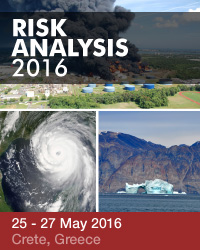Risk Analysis 2016
10th International Conference on Risk Analysis and Hazard Mitigation
25 - 27 May 2016
Crete, Greece
Overview

The 10th International Conference on Risk Analysis and Hazard Mitigation has been held in Crete, organised by Wessex Institute and sponsored by the International Journal of Safety and Security Engineering.
The conference covered a series of important topics of current research interests and many practical applications. This concerned all aspects of risk management and hazard mitigation, associated with both natural and anthropogenic hazards.
Current events help to emphasise the importance of the analysis and management of risk to planners and researchers around the world. Natural hazards such as floods, earthquakes, landslides, fires and others have always affected human societies. The more recent emergence of the importance of man-made hazards is a consequence of the rapid technological advances made in the last few centuries. The interaction of natural and anthropogenic risks adds to the complexity of the problems.
The papers presented at the Risk Conference covered a variety of topics related to risk analysis and hazard mitigation. All the papers are also archived in the WIT eLibrary (http://library.witpress.com/), where they are immediately and permanently available to the international scientific community.
Opening of the Conference
The meeting was opened by Prof Carlos A Brebbia, Director of Wessex Institute, who explained the importance of the Institute’s conference programme to disseminate advanced knowledge.
In addition to conferences and courses, the Institute has a very active publication programme which covers papers presented at conferences, published in Journals and specialised books. The conferences are held in different locations around the world.
WIT is actively involved in industrial research and collaborating with industry. This has led to the continuing development of a unique software system based on the Boundary Element Method, a technique which can be applied to solve a wide variety of problems. This led to the Institute becoming involved in a large series of interdisciplinary projects, some of which were described by Carlos, who stressed the commitment of WIT to collaborate with other organisations.
Invited Presentations
Following the opening address, the conference programme included a series of invited presentations, as follows:
- “From risk management to quantitative disaster resilience: a paradigm shift”, by Slobodan Simonovic, Western University, Canada.
- “Blind-testing experiments for interpreting spatial-prediction patterns of landslide hazard”, by Andrea Fabbri, University of Milano-Bicocca, Italy.
- Application of extreme value theory to oil spill risk analysis”, by Zhen-Gang Ji, Bureau of Ocean Energy Management, USA.
The paper presented by Prof Stavros Syngellakis of Wessex Institute contained some recent research results related to his work at WIT. It dealt with the effect of the impact of a projectile on ductile metallic armour. He compared expected analytical results with experiments carried out at the Sandia National Laboratories. His conclusion is that more experimental results are required to validate the analytical formulae presented.
The papers covered a wide variety of topics, listed under the following headings:
- Security issues
- Impact and blast loading
- Computational and experimental results
- Response of reinforced concrete under impact
- Dynamic analysis
- Infrastructures
- Risk assessment
- High velocity impact
- Dynamic material behaviour
The programme offered numerous occasions for interaction amongst the delegates which included coffee breaks on the terrace overlooking the sea. The lunches were excellent and held beside one of the hotel’s pools, creating a friendly atmosphere favourable to the exchange of information and discussion.
The members of the International Scientific Advisory Committee met over dinner to discuss ways in which the conference could be enhanced when it is reconvened in 2018. Several new topics were proposed as well as nominations for the Committee. There were some suggestions to hold the conference in a series of different locations in Europe, which are to be investigated by the Conference Division of WIT. Carlos ended the meeting by thanking the members for their work in promoting the meeting and contributing to its success, particularly by reviewing abstracts and papers.
Conference Dinner
The Conference Banquet took place in a tavern in a mountain village square, remote from the tourist spots. The dishes – different from those found around the coast – consisted of a series of Cretan starters, followed by a main course of lamb with rice. Drinks included, in addition to wines and raki, some special ones based on almonds and wild cherries.
A musical trio consisted of a Cretan lyre, lute and drum, played during the meal and when an ensemble in typical dress performed a series of Cretan dances, many of the delegates joined in towards the end. Overall, it was a most enjoyable evening.
Closing of the Conference
The Conference was closed by Carlos who expressed WIT’s gratitude to all participants for their contributions. He also referred to the recent decision of the Institute to make all papers available Open Access on its website. This will contribute to the dissemination of the work presented at Risk 2016 as widely as possible, as well as all other conferences organised by WIT. The same policy applies to the Journals programme. This policy, Carlos explained, has been taken in the interest of the scientific community, irrespective of any financial considerations.
Carlos also hoped that the delegates would consider visiting the WIT Campus when they are in the region, to better appreciate the value of the Institute and find ways of collaborating.
Related conferences
- ERES 2017,Alicante, Spain, 5 - 7 July, 2017
- SAFE 2017, Rome, Italy, 6 - 8 September, 2017
- Disaster Management 2017, Seville, Spain, 7 - 9 June, 2017


 Wessex Institute
Wessex Institute